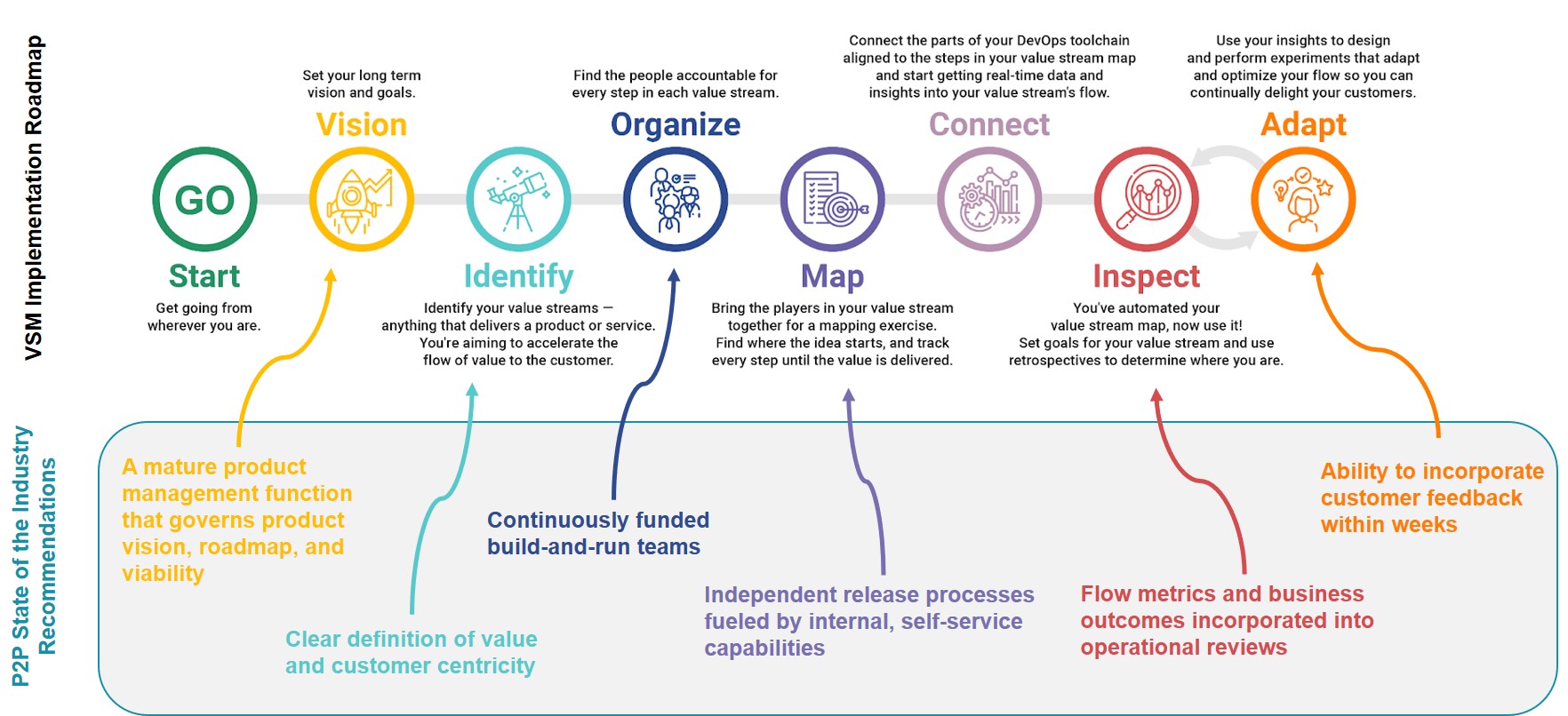Five years after the release of Dr. Mik Kersten’s seminal book, Project-to-Product, Planview announced last month the release of its inaugural Project-to-Product State of the Industry Report (March 15th, 2023).
In line with previous reports, such as our State of VSM Report 2022, the survey sheds light on the state of our digital industry. It does so through the lens of the operational model shift and deepens it with real data on +3600 products extracted and anonymized from Planview's systems.
“This report aims to help organizations shorten the time it takes to transition from a legacy project model into a mature and sustainable product operating model.“
Product-Centricity is Still in its Early Stages
If digital native companies have reached a high level of maturity, they remain in the minority. Most traditional enterprises are still at the beginning of their journey or are experimenting within teams or pilot projects... meaning that they have yet to fully benefit from a product delivery model.
.png?width=495&height=438&name=figure-1%20(2).png)
Figure 1 - Where are companies today in their progression? (Source: Planview)
As with Value Stream Management (VSM), traditional enterprises’ adoption of product operating models is still in its early stages, with very few organizations having operationalized a product-centric model at scale.
As we will see below, a shift from project to product requires change along multiple dimensions, a strong vision from executive leaders, and support from all levels of the organization.
Seven Dimensions of Change in the Shift from Project to Product
The study is structured around the seven dimensions of change that must be addressed to successfully operationalize a product model:
.png?width=578&height=396&name=figure-2%20(1).png)
Figure 2 - Seven dimensions of change in the shift from project to product (Source: Planview)
To benchmark your organization, you can use this online self-assessment which measures your current situation using these same seven dimensions. It only takes a few minutes to complete.
A Project Mode Anchored at all Levels
The report reviews a number of traditional practices that are so deeply rooted in the way organizations operate that they are becoming obstacles to their performance and digital transformation:
- Separate annual budget allocation for projects and run activities,
- Difficult collaboration or silos between business and engineering/IT teams,
- Up-front definition of large batches of work that is pushed to teams without regard to their ability to deliver,
- Unsustainable pressure to deliver more and more features at the expense of proactively allocating capacity to critical activities like risk management, security, and compliance,
- Multiple cross-team dependencies that delay releases, blocking or slowing the flow of value,
- Metrics focused on internal IT process efficiency rather than effectiveness in delivering value to customers,
- Inability to incorporate customer feedback within a few weeks for all but the top 10% of organizations.
Even though the Manifesto for Agile Software Development is more than 20 years old and DevOps is now almost 15 years old, the transition to a product model is far from complete.
For a more detailed view of the report’s findings, you can watch this on-demand webinar “Operationalizing the Shift from Project to Product” with Dr. Mik Kersten and Mara Puisite.
End-to-end VSM integrating Product Management and Engineering
What if VSM could help raise the anchor?
To successfully operationalize the shift to a product operating model, the report recommends relying on a Value Stream Management (VSM) approach, but also on concrete frameworks with a set of outcome-focused metrics.
“VSM organizes the processes of software delivery into product-focused value streams,
each of which delivers tangible business value to the customer.“
(Project-to-Product State of the Industry Report 2023)
.png?width=431&height=375&name=figure-3%20(1).png)
Figure 3 - A Toolkit for the Project to Product Shift (Source; Planview)
For software delivery, Flow Metrics measure these product value streams’ current performance as well as incremental improvements that occur during the shift to a product model and then allow organizations to continuously monitor their performance once they have operationalized the model.
These frameworks and practices apply to external value streams but also to the value streams that provide software delivery platforms to internal customers. To go further on this subject, see our previous article “Is Platform Engineering a Value Stream?” or the Planview Tasktop’s case study “How Platform Teams Are Using the Flow Framework® and Flow Metrics”.
The report’s main recommendations to successfully operationalize the shift to a product operating model fit very well within the VSM Consortium’s Implementation Roadmap:

Figure 4 - Project-to-Product State of the Industry Report Recommendations
The Value Stream Management (VSM) Implementation Roadmap is a series of high-level steps to guide an organization adopting VSM ways of working.
Set your long-term vision and goals
Product Management and Engineering must work hand in hand along the value stream.
For this, there is a need for strong and empowered Product Managers that govern product vision, roadmap, and viability.
Identify and organize around value streams
Adopting a customer-centric approach makes it possible to quickly identify the products or services that deliver value to customers, and as such, the digital value streams.
Funding for long term build-and-run teams should be reviewed more frequently in the context of actual customer value delivered and desired business outcomes.
Map and connect the value stream to optimize the flow of value
A Value Stream Mapping exercise allows all the actors (e.g. business leaders, product management, engineering) to accurately assess the current situation and to agree on the improvements to make in order to deliver more value. Use a Value Stream Management Platform (VSMP) solution that connects and automates the continuous calculation of metrics from the data in your tools along the chain.
In particular, the team can identify the main constraints that block or slow down the workflow, which may be caused by dependencies, handoffs, or other inefficiencies.
The report finds that release management activities can be identified as bottlenecks, with 30-40% time spent on them for multiple reasons. These dependencies should not only be managed but also reduced or ideally eliminated by means of self-service capabilities or process improvements.
Inspect the value stream health and value realization
Regularly inspect workflows and business outcomes, using observations, data and metrics collected automatically along the value stream.
Metrics must go beyond internal indicators or activity-based measurements and provide visibility into the end-to-end flow and the achievement of business outcomes.
Adapt continuously to customer needs and feedback
Use the insights to continuously adapt and delight your customers. The goal of agility is to accelerate customer feedback loops and have the capacity to integrate them very quickly, within a few weeks at the most. The feedback loop is possible when strong product management maintains regular, direct contact with customers of their digital products or services.
“With appropriate prioritization, a concrete roadmap, and a data-driven approach, organizations can accelerate the remainder of their journey and achieve faster delivery that supports the business’s transformation to digital services.“ (Project-to-Product State of the Industry Report 2023)
Planview Resources
- Download the Project-to-Product State of the Industry Report 2023
- Book Project to Product - How to Survive and Thrive in the Age of Digital Disruption with the Flow Framework by Mik Kersten, 2018
On the same subject, don't hesitate to consult our previous posts:
- Organizational Considerations in VSM
- Is Platform Engineering a Value Stream?
- Is Release Management a Value Stream?
- Is Incident Management a Value Stream?
- How to Make Time for VSM
See also our research and learning from here:
And finally, an index of Industry Reports on my website.
Picture credits: Shutterstock

Patrice Corbard
Patrice is VSMC's Head of Content Value Stream, and a Consultant, coach, and trainer in DevOps, Value Stream Management, and Agile. He's the founder of SD ReFocus, which applies VSM principles and practices to focus software delivery on customer value.








Comments 0